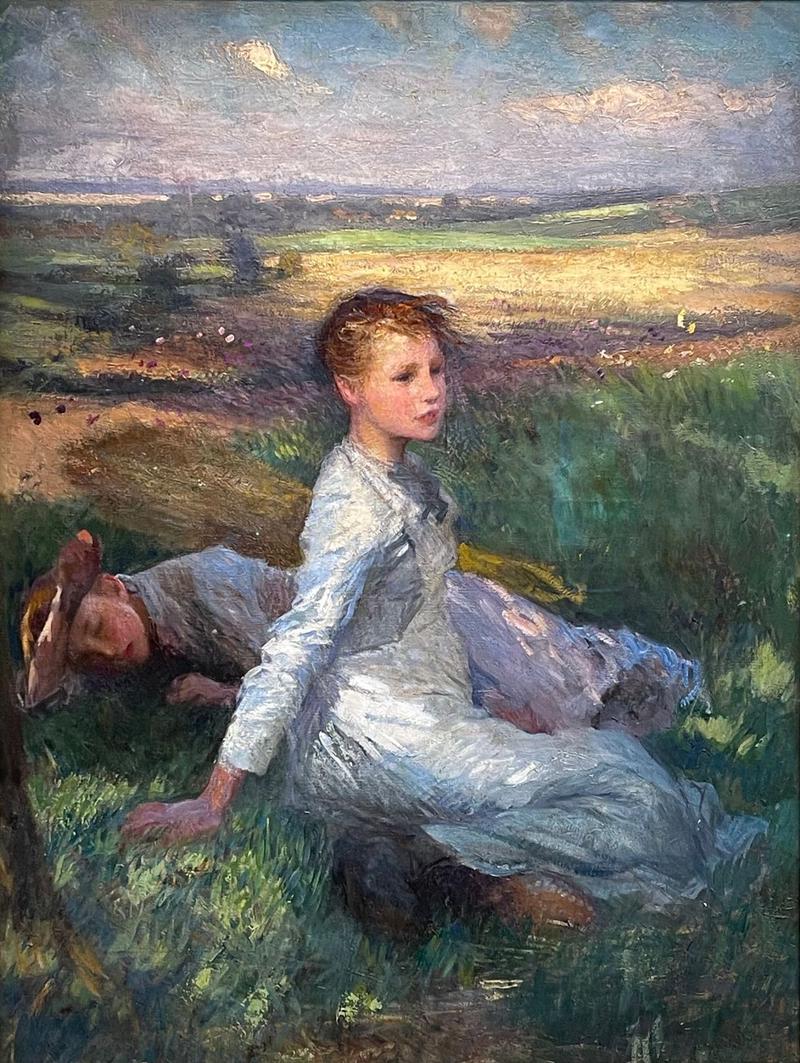Summer in the Fields

By the turn of the century Clausen’s Impressionist handling was instantly recognised by critics. His palette was rich and varied; he saw colour in shadows and was fully aware of the visual excitement of complementary colour contrasts. In the depiction of landscape he often adopted an aerial viewpoint locating foreground figures on a plane which takes the spectator confidently from the foreground, through the middle distance to the background. In these works a windswept sky with scudding clouds occupies the upper third of the canvas. Summer in the Fields is the first of this new sequence of canvases in which Clausen returns to problems he had first tackled as a young painter under the spell of Bastien-Lepage. Both Bastien and Lhermitte, unlike their Barbizon predecessors, sought to take a bird’s eye view of field work, sacrificing none of the circumstantial detail of the landscape in which it occurs. This was the essential appeal of Bastien-Lepage’s Les Foins, 1878 (Musée d’Orsay, Paris), a work which Clausen had studied at length in the Grosvenor Gallery exhibition of 1880. This challenging depiction of exhausted field workers shows a foreground female reaper looking out of the picture, while her male companion lies sleeping behind her. In Summer in the Fields, we see two girls who have been hay-making, one of whom has fallen asleep on the grass at the edge of the field, like the male harvester in the background of Bastien’s work.
Clausen moved quickly from this work into a sequence of paintings of labouring gangs. The resting girls are replaced by foreground figures working in unison in Sons of the Soil, 1901 (private collection), Harvest, Tying the Sheaves, 1902 (Christie’s, London, 20 November 2000, lot 26) and Harvest: In the Beanfield, 1904 (Durban Art Gallery). In each, the groups are contained within a clearly defined foreground space, which Clausen surveys from a high vantage point. The effect is to give equal prominence to figures and setting.
Summer in the Fields appears not to be listed in the artist’s account books, although there is a gap in his record keeping between September 1896 and October 1897. There is also the possibility that originally it may have been known under a different title from that which it acquired for the posthumous sale. An independent oil painting of the sleeping girl passed through the Fine Art Society, London, at the end of the 1980s. Other studies for the picture elucidate the process of its conception. An unfinished drawing of the seated figure is contained in the Royal Academy. The Victoria and Albert Museum, London, has a more finished study of this figure and a drawing of the ensemble (E1941-1946), while the Holburne Museum, Bath, has a further head study, and all portray the young woman in the foreground. The composition is thematically related to a whole sequence of works showing resting fieldworkers, the most important of which had been Evening Song, shown at the Royal Academy in 1893 (Christie’s, New York, 22 October 1997, lot 139). Both canvases share the same warm palette and both demonstrate the degree to which the painter sought to imitate in oil, the effects he had achieved in pastel.
In Summer in the Fields, the principal figure straightens her back against the stiff breeze, as though she has been roused by a distant call. At this time the painter was interested in the familiar theme of lark-song. The girl’s face is thrown into relief by surrounding touches of mauve and viridian that animate the terrain, as one field overlaps with another in the middle distance. The landscape is clearly drawn from the area around Tilty and Clavering, near the painter’s home at Widdington. Small dabs of colour contrast with the swiftly scratched strokes of the sunlit grass upon which the two girls rest. In the sky area there is evidence of the use of palette knife in the application of heavy pigment. Colour and handling of this variety equates Summer in the Fields with works such as Rest, 1896 (Queensland Art Gallery, Australia) and The End of a Long Day, 1898 (Art Gallery of Western Australia, Perth). There is nevertheless an air of experimentation about the picture. In his fluid execution, the painter was less preoccupied with surface detail than formerly, and as the leading British Impressionist of his generation, he clearly wished to avoid the pitfalls of conventional Academy landscape painting.
We are very grateful to Professor Kenneth McConkey for providing the above catalogue entry.



